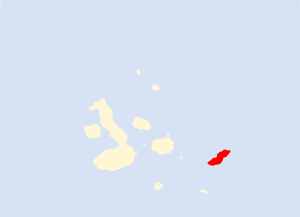San Cristóbal flycatcher facts for kids
Quick facts for kids San Cristóbal flycatcher |
|
|---|---|
| Conservation status | |
| Scientific classification | |
| Genus: |
Pyrocephalus
|
| Species: |
dubius
|
 |
|
| Synonyms | |
|
|
The San Cristóbal flycatcher (Pyrocephalus dubius) was a small, colorful bird. It was also known as the San Cristóbal vermilion flycatcher. This bird used to live only on San Cristóbal Island in the Galápagos Islands. It was a type of vermilion flycatcher. Sadly, this bird is now extinct, meaning there are no more left alive. Famous scientist Charles Darwin saw this bird during his trip to the Galápagos in 1835.
Contents
About the San Cristóbal Flycatcher
How Scientists Classified This Bird
Scientists group living things into categories. This helps them understand how different species are related. The San Cristóbal flycatcher was first described as its own species, Pyrocephalus dubius, in 1839 by a scientist named John Gould.
Later, some scientists thought it was just a subspecies. A subspecies is a group of animals within a species that has small differences. They thought it was a subspecies of the widespread vermilion flycatcher. However, recent studies in 2016 looked at the bird's DNA. These studies suggested that the San Cristóbal flycatcher was different enough to be its own species again. Many bird experts now agree with this idea.
What the San Cristóbal Flycatcher Looked Like
The San Cristóbal flycatcher was a small bird, about 10.8 to 11 centimeters (around 4 inches) long.
Male Bird's Colors
The male birds were very striking. Their heads had a shiny, dark red color. Their chests and throats were also a bright, pale red. This color became even brighter on their chests. The area around their eyes and the top parts of their bodies were dark brown.
Why the San Cristóbal Flycatcher Disappeared
When the Birds Were Last Seen
In 1929, a scientist named Albert Kenrick Fisher saw many of these birds. They were found along the dry western coast and up into the highlands. However, over the next 60 years, things changed a lot on San Cristóbal Island.
Problems for the Birds
One big problem was that new plants started to grow. These were plants that were not native to the island. They took over the areas where the flycatchers lived. This meant that the native plants, which the birds' food insects depended on, started to disappear. When the insects disappeared, the flycatchers had less to eat.
By the 1980s, scientists David and Lee Steadman visited the island. They said the San Cristóbal vermilion flycatcher was extremely rare. The very last time anyone reliably saw one of these birds was in 1987.
The Search for the Birds
In 1998, a team spent six months searching the island. They looked everywhere, but they could not find any San Cristóbal flycatchers. This was a sad sign that the bird was gone.
Scientists believe several things led to the bird's extinction:
- Less Food: As mentioned, the insects they ate became scarce.
- Diseases: Diseases like avian pox and avian malaria might have also harmed the birds.
In 2016, after many years of study, the Durrell Wildlife Conservation Trust announced that the San Cristóbal flycatcher was the "first bird extinction in Galapagos." This was a very sad moment for wildlife conservation.
See also
 In Spanish: Mosquero de San Cristóbal para niños
In Spanish: Mosquero de San Cristóbal para niños


